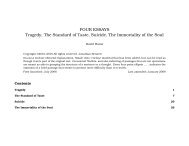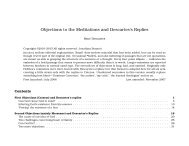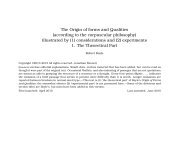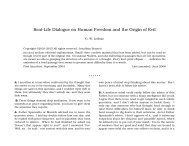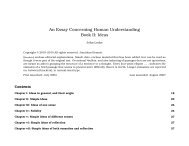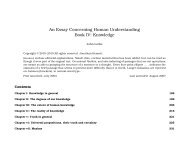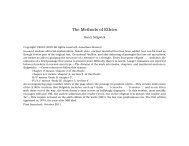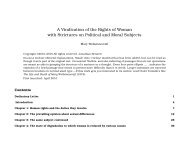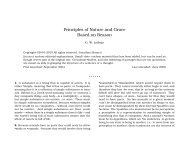The Form and Principles of the Sensible and Intelligible World
The Form and Principles of the Sensible and Intelligible World
The Form and Principles of the Sensible and Intelligible World
Create successful ePaper yourself
Turn your PDF publications into a flip-book with our unique Google optimized e-Paper software.
<strong>The</strong> <strong>Sensible</strong> <strong>and</strong> <strong>Intelligible</strong> <strong>World</strong> Immanuel Kant III: <strong>The</strong> form <strong>of</strong> <strong>the</strong> sensible world<br />
follows that it’s a pure intuition, not a sensual one.<br />
(iv) Time is a continuous quantum <strong>and</strong> is <strong>the</strong> principle <strong>of</strong><br />
<strong>the</strong> laws <strong>of</strong> continuous change in <strong>the</strong> universe. A quantum<br />
is continuous if it isn’t made up <strong>of</strong> simple parts, <strong>and</strong> that’s<br />
<strong>the</strong> case with time. ·Here is an argument which shows this·.<br />
•When you think about time you’re thinking only <strong>of</strong><br />
•relations, not <strong>of</strong> things or events that are thus related.<br />
And so<br />
•in time as a quantum <strong>the</strong>re is compositeness, but<br />
if you think <strong>of</strong> this compositeness as completely removed<br />
<strong>the</strong>n <strong>the</strong>re’s nothing left; <strong>and</strong><br />
•if <strong>the</strong>re’s nothing left <strong>of</strong> a composite x when all compositeness<br />
is removed, <strong>the</strong>n x isn’t composed <strong>of</strong> simple<br />
parts [because o<strong>the</strong>rwise <strong>the</strong>y would be left].<br />
Q.e.d. So every part <strong>of</strong> time is itself ·a period <strong>of</strong>· time. Time<br />
does involve items that are simple, namely instants; but <strong>the</strong>y<br />
aren’t •periods <strong>of</strong> time; <strong>the</strong>y are •boundaries between periods<br />
<strong>of</strong> time. . . .<br />
<strong>The</strong> metaphysical law <strong>of</strong> continuity says that all changes<br />
are continuous. Something cannot go from being F to being<br />
G (where <strong>the</strong>se are mutually inconsistent) except through<br />
an intermediate series <strong>of</strong> different states. For two opposite<br />
states are at different instants <strong>of</strong> time, but between <strong>the</strong> two<br />
instants <strong>the</strong>re would always be some intervening time <strong>and</strong><br />
in <strong>the</strong> infinite series <strong>of</strong> moments <strong>of</strong> that time <strong>the</strong> substance<br />
is not ei<strong>the</strong>r F or G <strong>and</strong> yet it is not in no state! So <strong>the</strong><br />
substance will be in states o<strong>the</strong>r than F <strong>and</strong> G, <strong>and</strong> between<br />
any two <strong>of</strong> those states <strong>the</strong>re will be intervening states,<br />
<strong>and</strong> so on ad infinitum. <strong>The</strong> conclusion, <strong>the</strong>n, is that <strong>the</strong><br />
change from F to G—·which is a st<strong>and</strong>-in for any change<br />
whatsoever·—is continuous.<br />
11<br />
[Kant now has a paragraph reporting a thoughtexperiment<br />
by which ‘<strong>the</strong> celebrated Kaestner’ explored<br />
Leibniz’s <strong>the</strong>sis that all change is continuous. It has to<br />
do with <strong>the</strong> movement <strong>of</strong> a point through an angle, <strong>and</strong><br />
concludes that if all change is continuous <strong>the</strong>n a body can<br />
change direction only in a curve. <strong>The</strong> argument turns on<br />
how •<strong>the</strong> last instant when <strong>the</strong> point is moving into <strong>the</strong> angle<br />
relates to •<strong>the</strong> first instant when it is moving out <strong>of</strong> <strong>the</strong> angle;<br />
but if time is continuous <strong>the</strong>re are no such two instants, <strong>and</strong><br />
<strong>the</strong> argument collapses.]<br />
(v) Time is not something •objective <strong>and</strong> real, not a substance<br />
or accident [see Glossary] or relation; ra<strong>the</strong>r, it is a<br />
condition that has to be satisfied if sensible things are to<br />
be inter-related by fixed laws. It’s <strong>the</strong> nature <strong>of</strong> <strong>the</strong> human<br />
mind that sets this condition, so it is •subjective. It is a pure<br />
intuition. [This indented passage is an addition to what Kant wrote.]<br />
It’s an intuition because it is tied in with sensibility;<br />
it is something we confront in our experience, not<br />
something abstract <strong>and</strong> intellectual. And it is pure<br />
because it doesn’t have any empirical content; it is <strong>the</strong><br />
required background against which, or frame within<br />
which, empirical content reaches us.<br />
It’s only through <strong>the</strong> concept <strong>of</strong> time that we co-ordinate substances<br />
<strong>and</strong> accidents as being simultaneous or successive;<br />
<strong>and</strong> so <strong>the</strong> notion <strong>of</strong> time, as being what gives form to our<br />
sensory intake, is prior to <strong>the</strong> concepts <strong>of</strong> substance <strong>and</strong><br />
accident. . . .<br />
Those who assert <strong>the</strong> objective reality <strong>of</strong> time go in one<br />
<strong>of</strong> two ways. (a) English philosophers, especially, think <strong>of</strong><br />
time as some continuous flux that exists but doesn’t involve<br />
any ·o<strong>the</strong>r· real things—a preposterous view! (b) Leibniz <strong>and</strong><br />
his followers think <strong>of</strong> time as something real, abstracted<br />
from <strong>the</strong> succession <strong>of</strong> internal states. <strong>The</strong> falsity <strong>of</strong> this<br />
can be seen in •<strong>the</strong> vicious circle in <strong>the</strong> definition <strong>of</strong> time




